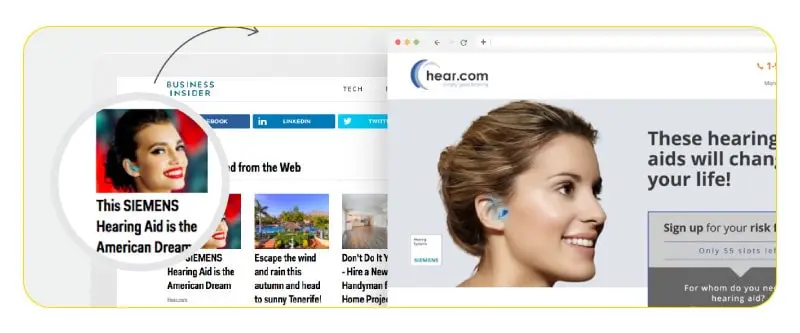These days, people are elusive toward advertising more than they have ever been. And it makes sense. The world is full of ads. Anywhere you look, from streets and public places to social networks and websites, countless different brands try to sell you something. The more aggressive they are, the more annoying it gets. Ads are disruptive in their nature. This fallout makes even more sense when you consider the content of the ads. Unfortunately, countless times brands have bragged in their ads, only to fail to live up to their promises.
As a business owner or advertiser, have you ever tried to look through the consumer’s eyes? People are literally bombarded with different types of ads every day. In the digital age, almost every online platform has some capacity to serve ads to a large audience for a reasonable price. And while digital advertising is arguably the most efficient marketing method available, it still has to deal with a very problematic phenomenon: Ad fatigue. Simply put, the audience gets sick of seeing so many ads while venturing into its online habitat. Native advertising has emerged to counter that effect, and it does it quite well. But the thing is, utilizing native ads in your strategy means walking on a very thin line between respecting the online experience of your audience and masking the true nature of your ads.
What is Native Advertising? As a business owner or advertiser, have you ever tried to look through the consumer’s eyes? People are literally bombarded with different types of ads every day. In the digital age, almost every online platform has some capacity to serve ads to a large audience for a reasonable price.
Compared to other more traditional digital advertising methods, native is less aggressive and salesy, with a heavy focus on disguising as organic content and not having an impact on user experience. To achieve this goal, native ads mimic the look and feel of other organic content on the platform they’re being served on, but they always have a subtle indicator that gives away their true nature. What’s great about them is that they actually work. Native ads are successful in grabbing people’s attention and marketing something to them without being annoying and salesy. The result is more impression, more click-through rate, and ultimately, higher return on investment. Native counters the effect of ad fatigue and have a huge potential to connect you with your prospects. In 2016, it was estimated that native display ads will make up 74% of total display ad revenue in the US by 2021. Skipping out on native advertising means giving up on a golden opportunity to remarket and attract customers with lower buyer intent.
Native ads mimic the look and feel of their surrounding organic content. The objective here is to have little impact on the user’s experience. Native ads are designed to match the visual language, function, and tone of the place they’re being served on. As a result, people tend to be kinder to them and don’t dismiss them just as easily as they ignore traditional ads.

Running a native advertising campaign is usually trickier than traditional campaigns. Since the whole point is to be non-invasive and non-disruptive, you need to test different combinations of ad copy, headlines, and creative assets to find out which one works best. In addition to having a smaller impact on people’s online experience, good native ads bring value. Successful native campaigns focus on what the reader/viewer wants to see.
Native advertising has been very successful in preventing ad fatigue, and the method is already very popular in the marketing world. The classic example of a native ad is an advertorial, which is an advertisement in print media that appears as an editorial article. Native ads usually try to bring value by addressing a common problem of the target audience and providing the advertiser’s product or service as a solution.
While this type of advertising feels a bit deceitful, it’s actually not that duplicitous because government authorities oblige businesses to tell viewers that they’re seeing ads. That’s why there’s always a small phrase or tag on the native ads’ widgets that indicates they’re Sponsored Content or Paid Promotions. Publications and advertising channels charge brands for running native ads based on cost-per-click (CPC) or cost-per-mille (1000 impressions).

Native ads have many formats since they basically imitate the shapes of the other content on their publication platforms. This means they could be photos, videos, infographics, podcasts, articles, and blog posts. A very good example is Google’s paid search channel. The paid results you see on the search engine result pages look exactly like other normal links, except they have a tiny Ads indicator below them. However, the diversity of native ad formats could lead to confusion, since they can overlap with other ad types.
This method could be considered an extension of content marketing. It’s not a major marketing approach itself, but an advertising method that takes advantage of the already established audience of a third-party platform. Native ads are distributed on outbound marketing channels like social media or print media and enable brands to find new customers and skip the lengthy process of building a fan base. However, it comes with a cost. Since the serving platform does not belong to the brand, it has less control over certain aspects and must pay the platform owner for the distribution of its content.

Final thoughts
With each passing year, native advertising is getting more attractive for marketers who are looking for a highly-efficient, scalable way to engage with their audience, without exhausting them with disrupting, boring paid content. With the right attitude and good knowledge of your target audience, native advertising could become a big win for your business. The important thing here is to put yourself in your audience’s perspective. Native ads don’t just mimic their surrounding organic content. They bring value to viewers, and attract their attention with relevant, helpful content that also promotes a brand or a product.










